Frequently asked questions and answers for Limit Switches - Industrial Automation
Question
What is the difference between WL01CA2 Limit Switches and the WLCA2?
Answer
The "01" in WL01CA2 means that it is for microloads.

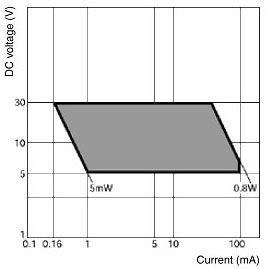
Question
Is it possible to purchase only the head portion of WL Limit Switch?
Answer
Yes, replacements are available.
Head and Actuator
Example:
Set
WLCA2 Limit Switch
Head and Actuator
WL-1H1100 Limit Switch
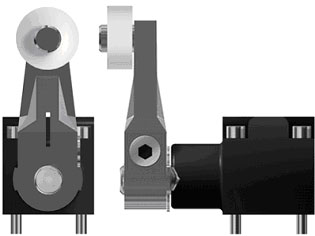
Head without Actuator
The model numbers for Heads without Actuators are the model numbers for Heads with Actuators minus the numbers after WL-[]H.
Example:
Set
WLCA2 Limit Switch
Head and Actuator
WL-1H Limit Switch
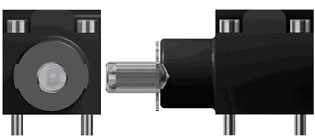
Rotary Lever Actuators
Example:
Set
WLCA2 Limit Switch
Actuator
WL-1A100 Limit Switch
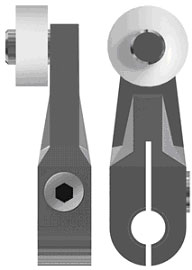
Question
Can the lever of a WL General-purpose Limit Switch be mounted on WLF2 Explosion-proof Limit Switch?
Answer
The lever can be mounted, but it can't be used for explosion-proof specifications. WLF2 is certified as explosion-proof as a whole with the lever.
Note:The WLF2 and WL levers each have different mounting bolt specifications (surface treatment).
Note:For use with explosion-proof specifications, mount the WLF2CA2 Lever as a replacement lever for the WLF2CA2.
Can the mounting position of an actuator be changed?
AnswerThe mounting position of a lever type actuator can be changed.
Applicable models
Roller Lever type
Adjustable Roller Lever type
Adjustable Rod Lever type
Fork Lock Lever type

Can WLNJ Limit Switch be used so that a bent coil spring becomes straight after striking the dog?
Do not use the WLNJ this way. The spring may become deformed.
Is it OK to not ground the blue (black) lead wire if the socket unit of D5C Limit Switches is grounded?
No, it must be grounded. The socket unit and the lead wire are insulated, so the lead wires must be grounded.
Is it possible to replace only the Actuator for WLNJ Limit Switches with a coil spring?
No, it is not possible to change only the Actuator. Use WL-9H100 Head (with integrated actuator).
What connectors should be used for Limit Switches?
SC-series Limit Switch Connectors are available. Select the Connector according to the size of the conduit port and the external diameter of the cable to be used.

Note:
1.Use SC-21 to SC-25 together with the rubber ring and conduit washer for the SC-P2.
2.It is necessary to use sealing tape with SC Connectors. SC-1M to SC-5M, however, are provided with an O-ring (NBR) and therefore sealing tape is not necessary to ensure a proper seal.
SC-P2 accessories and sealing tape must be used together with models without an O-ring in order to prevent ingress of oil or water.



Note:Dimensions not shown in the above diagrams have a variation of ±0.4 mm.
*Diameter of Part Marked with Asterisk

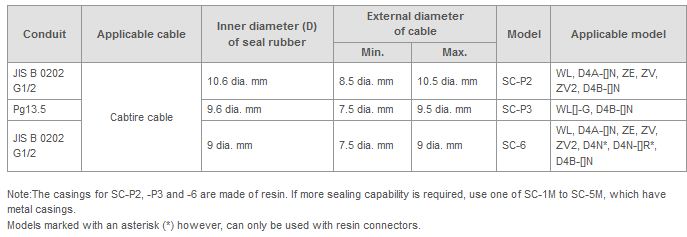



Note:Dimensions not shown in the above diagrams have a variation of ±0.4 mm.
*Diameter of Part Marked with Asterisk
The SC-[]F[] is a snap-on connecting model that greatly reduces the time-consuming effort for wiring the Limit Switch. The SC-[]F[] is easily and quickly connected or disconnected and its degree of protection is IP67.




What are the different uses for WLNJ Limit Switches and WLNJ-30 Limit Switches?
Because the coil spring is a single wire, the rod flexes considerably. Use WLNJ when the arrival position of the sensing object fluctuates.
The flexibility of the rod, however, causes gaps to appear in the coil spring. These gaps may cause foreign matter to be caught or accumulate.
The coil spring consists of three tightly wrapped wires, so there is almost no flexibility in the rod. Also, no gaps form in the coil spring.


What degree of protection is provided against water?
Levels of protection are provided up to IP67.
Are holding Limit Switches available?
Fork lever lock models are available.
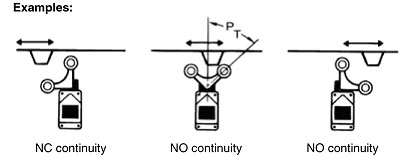
Applicable models: WLCA32-41 Limit Switch, WLCA32-42 Limit Switch, WLCA32-43 Limit Switch
Can the actuator of WL Limit Switch be mounted on other Limit Switches?
Lever actuators can be mounted on the following models.
Applicable models: HL Limit Switch, D4C Limit Switch, D4CC Limit Switch, D4AN Limit Switch
Note:The roller weight will increase when a large the WL lever roller or long lever is used.
Mounting these types of levers on the HL, D4C, or D4CC may result in reset failure. Use the Limit Switch with the lever mounted downward.
Are the Heads for WL Limit Switch all interchangeable?
Some Heads are interchangeable and some are not.
WL-series Head Interchangeability
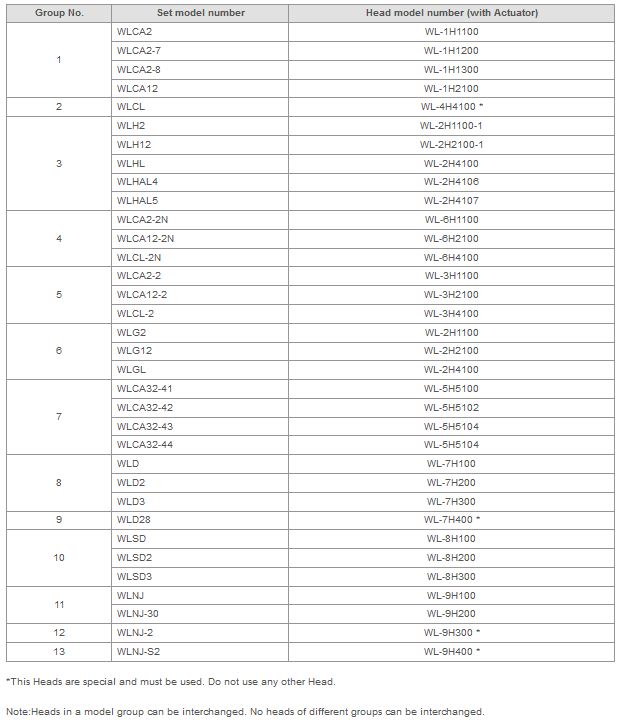
Is WL Limit Switch available with connectors?
Models with directly attached connectors and models with pre-wired connectors are available.

XS2F Cable is used to connect to models with directly attached connectors and models with pre-wired connectors.
What is the difference between the stainless steel and the stainless sintered alloy?
It is made by cutting a block of stainless steel.
It is used for a roller of the spatter-prevention type limit switch because spatter hardly adheres to it.
It is made by alloying stainless steel powders by applying pressure and heat in a mold. Stainless steel powders with oil soaked through their particles are used for a roller.
Roller abrasion and smear mark appear at the same time, and thus abrasion resistance of the roller is enhanced.
What types of conduit openings of the Limit Switches are available?
The conduit opening is a hole to pull out a cable. The hole is threaded to fit a connector for fixing the cable.
This connector ensures mechanical fixation and sealing characteristics of the cable.

PF and PS are currently indicated in JIS. They are, however, prescribed in the Appendix, and will be discontinued when the JIS standard is reviewed.
Nominal designations for Conduit Threads of switches for overseas use are indicated in a conventional manner without any change.
Just for reference, their indication methods are described below.

Are Limit Switches available that can be used outdoors?
Note: Do not expose the Limit Switch directly to wind, rain, or sunlight.
What color is the operation indicator of WL Limit Switches?
LED: Neon lamp
Red: Orange
WLCA2-2LD "LD" is for the LED.
WLCA2-2LE "LE" is for the neon lamp
How do you calculate the operating force (OF) when changing the length of an adjustable roller lever in Limit Switches?
Use the following equation:
OF' = (OF x R)*/R'
*(OF x R): Fixed torque
Where OF is operating force, R is roller lever length, R' is the desired roller lever length, and OF' is operating force for the desired roller lever length.
For example, using the WLH12 Limit Switch with a roller lever length of 89 mm will result in the following OF':
(9.81 N x 38 mm)*/89 mm = Approx. 4.19N
*9.81 N: Standard OF
38 mm: Lever length for standard OF
In the above equation, the standard OF for a WLH12 with a roller lever length of 38 mm is 9.81 N (the OF listed in the datasheet), so the fixed torque is calculated as OF x R.
Dividing this by R' (89 mm in this example), which is the desired roller lever length, gives us the OF', which is the operating force for a Limit Switch with the desired roller lever length.
What is the difference between one-side operation and both-side operation in WL Limit Switches?
With one-side operation, Switches will only operate when the lever is pushed in one direction, left or right. They will not operate when it is pushed in the other direction. With both-side operation, Switches will operate when the lever is pushed in either direction.
One-side operation Switches operate as shown in the following figures.
The output of the Switch will be changed, regardless of which direction the lever is pushed.
The output of the Switch will only be changed when the lever is pushed in one direction
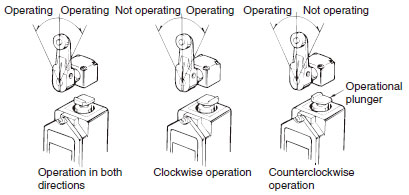
Loosen the cam holder with a coin or screwdriver. Take out the cam from the Switch.
Change the direction of the cam as required by your intended operation and then reinstall the cam
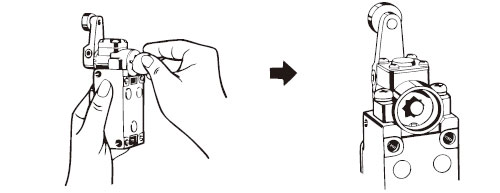

What are the differences between WL[][]-2 Limit Switch and WL[][]-2N Limit Switch ?
The WL[][]-2 has a lever with 90 ° operation to each side, with one-side operation not possible, and a Head that can be mounted in four directions.
The WL[][]-2N has a lever with 90 ° operation to each side, with one-side operation possible, and a Head that can be mounted in two directions.
One-side operation means that three operational directions can be selected electrically, according to the change in the direction of the operating plunger or cam. The three selectable operational directions are "Operate and Operate," "Operate and Not Operate," and "Not Operate and Operate." The models for which one-side operation is not possible can only operate on both sides.
Is the inscription "NEMA A600 TYPE 3.4 and 13" on WL Limit Switches the model number?
No, it is not the model number. NEMA 600 expresses the rating code used in UL standards.
How can I convert grams (g) for force in the operating characteristic to Newtons (N)?
Use the following formula to convert kgf (kilogram-force) to N (Newtons):
1 kgf = 9.80665 N
Therefore, 1 N is equivalent to approximately 102 g.
1 gf to 1/102 N
Example: 140 gf to 1.37 N
The unit for force in the operating characteristics for switches was previously expressed mainly in gram-force (g-f). Presently, however, the unit Newtons (N) is used under the new Japanese Measurement Law that went into force in 1992.